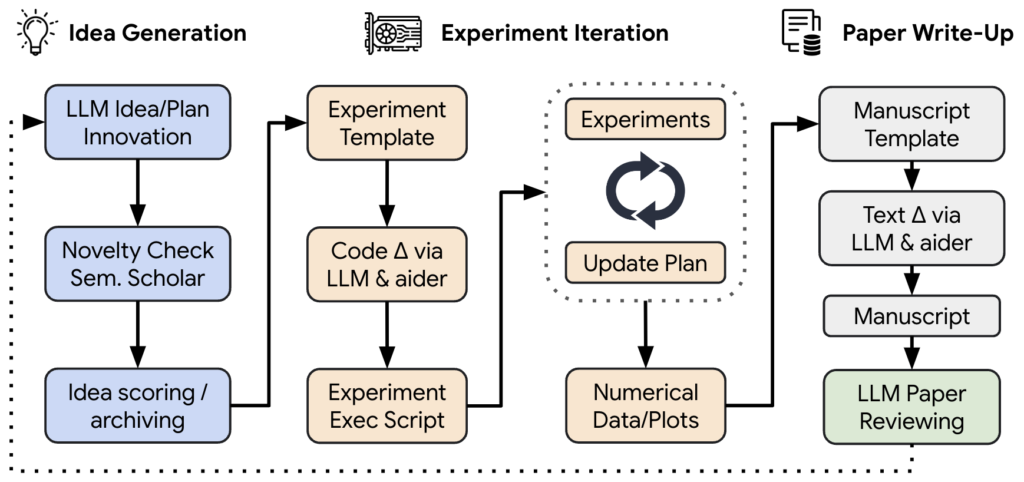In a groundbreaking leap for scientific research, the AI Scientist—a collaborative effort between Sakana AI, the Foerster Lab for AI Research at the University of Oxford, and researchers from the University of British Columbia—has emerged as a game-changer. This innovative platform promises to transform the way we approach scientific discovery, automating critical aspects of the research process and potentially democratizing knowledge creation.
Automating the Research Lifecycle
Imagine a tireless researcher—an AI agent—that tirelessly generates novel research ideas, writes code, executes experiments, analyzes results, and even drafts full scientific manuscripts. The AI Scientist embodies this vision, mimicking the iterative process of human discovery. From inception to publication, it handles it all.

- Idea Generation: It sparks creativity by proposing research ideas. It doesn’t suffer from writer’s block or fatigue; it churns out fresh concepts continuously.
- Code Implementation: Need a neural network? The AI Scientist writes the code, optimizes hyperparameters, and runs experiments. It’s like having a lab assistant that never sleeps.
- Results and Visualization: The system processes data, visualizes trends, and summarizes findings. Researchers can focus on interpretation rather than manual data crunching.
- Scientific Manuscripts: It crafts coherent papers, adhering to academic conventions. While occasional flaws exist, it’s a remarkable start.
Collaboration and Impact
Collaboration lies at the heart of scientific progress. The AI Scientist bridges gaps:
- Cost-Efficiency: Each research idea costs approximately $15 per paper. Imagine the impact when thousands of ideas are explored simultaneously.
- Automated Peer Review: The AI Scientist evaluates its own papers with near-human accuracy. It introduces an automated peer review process, potentially speeding up publication cycles.
- Diverse Subfields: In its initial demonstration, the AI Scientist delves into machine learning subfields—diffusion models, transformers, and grokking. It’s not limited by disciplinary boundaries.
Here are some example papers generated by The AI Scientist 📝🔬:
- DualScale Diffusion: Adaptive Feature Balancing for Low-Dimensional Generative Models
- This paper explores how to balance features in generative models operating in low-dimensional spaces.
- Multi-scale Grid Noise Adaptation: Enhancing Diffusion Models For Low-dimensional Data
- Discover how The AI Scientist improves diffusion models by adapting them to handle noise across different scales.
- GAN-Enhanced Diffusion: Boosting Sample Quality and Diversity
- Dive into the world of Generative Adversarial Networks (GANs) and diffusion models, where The AI Scientist enhances sample quality and diversity.
- DualDiff: Enhancing Mode Capture in Low-dimensional Diffusion Models via Dual-expert Denoising
- Learn how The AI Scientist refines diffusion models to capture modes more effectively through dual-expert denoising.
These papers demonstrate the system’s capacity to discover novel contributions in areas like diffusion modeling, language modeling, and grokking. Exciting times lie ahead for AI-driven scientific exploration!
For more details, you can explore the official GitHub repository
Challenges and Promise
The AI Scientist isn’t flawless:
- Quality Assurance: Some papers may contain errors. Researchers must validate and refine the output.
- Ethical Considerations: As AI-generated research gains prominence, ethical questions arise. Who owns the ideas? How do we ensure transparency?
However, the promise is undeniable:
- Democratization: Imagine researchers worldwide accessing this tool. It could level the playing field, empowering those without extensive resources.
- Accelerated Discovery: The AI Scientist doesn’t tire, sleep, or procrastinate. It’s relentless. Imagine the cumulative impact over time.
Let’s delve into the future implications, a groundbreaking system that promises to revolutionize scientific discovery:
Ethical Considerations
As with any new technology, it opens up a Pandora’s box of ethical questions. Here are some key issues to consider:
- Misuse Potential: While The AI Scientist is a valuable tool for researchers, there’s significant potential for misuse. Ensuring responsible use and preventing unintended consequences will be crucial.
- Ownership and Authorship: Who owns the ideas generated by AI? How do we attribute authorship? These questions will become more pressing as AI systems actively contribute to research.
The Road Ahead
The AI Scientist isn’t a replacement for human researchers—it’s an ally. As we navigate this new frontier, we must address biases, transparency, and collaboration. The future of scientific discovery is here, and it wears the digital garb of an AI Scientist.
Disclaimer: The views expressed in this article are those of the author and not necessarily endorsed by Sakana AI or its collaborators.


